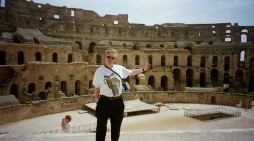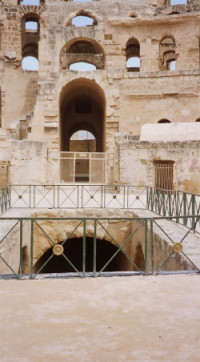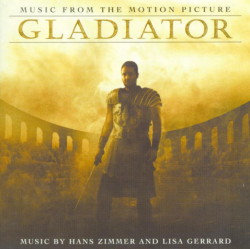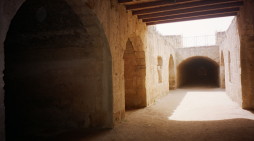
On the dusty road few kilometres ahead, I could see this majestic monument
rose up. It was like travelling back in the past.
El Jem is a small city with only 7000
inhabitants. It's also a quite place without much character except from the
historical sites. About 30 Roman villas have been found here. El Jem has been
an old trading centre for the Roman emperors, with connected routes trough central Tunisia.
I had just seen the great movie Gladiator with Russell
Crowe in the main role as Maximus. Finally I was there. In all it pride the
great amphitheatre stood straight ahead of me. I remember the brutal fighting
scenes from the movie when the hero entered the arena in Thysdrus (El Jem). It
was so brutal that it still sends shivers down my spine. Thysdrus is built of ocre stone (soft sandstone), and it's
a living evidence of a brutal past. In the surrounding area there are ruins
of two smaller amphitheatres.
The name Thysdrus first appeared in the history around the middle of the
first century B.C. at the time of Julius Caesar's African war. He was camping
near Russina (Monastir) when a delegation came to tell him that they had in
store 26,252 hectolitres (about 70,000) bushels) of wheat belonging to their
farmers and some Italian Merchants, and they requested a garrison to protect
their goods.
Photos. The great amphitheatre inside. The bizzare
entertainment will never be forgotten, and hopefully not relaunched.
Construction period: built between 230 and 238 A.D.
I was
daydreaming when I walked around in the ca. 2000 year old amphitheatre. The entertainment was
something for itself. I wondered how the 30,000 spectators reacted when they could
see mock hunting, wild beast fighting each others, or martyrs, slaves or prisoners
of war thrown in to the wild animals.
Did they call for more blood? Did they really enjoy the entertainment? The
adreline must have rose up to big heights, both for the half-naked gladiators,
and for the blood thirsty crowd. These scenes are reproduced on some of the
mosaics found in El Jem itself.
In the modern world we get our
entertainment through Cinema, TV and theatres. It could also be brutal, but fortunately most
of it is performed by acting. People need to be entertained in one
or another way.
With the same attitude as in the past, I could barely think of what kind of
entertainment people today would have arranged if the Cinema, TV and theatres
haven't been available. But I know that there are illegal fighting clubs around
in the world that arranges fights without rules.
|
Just as the Gladiators fights there are no mercy. Gladiators had short
carriers. One day they could get applause and cheers from the crowd, next
day they could end up as a dinner snack for a lion or speared by a sword.
For they who survived, they continue their bloody carrier in the
Collesseum in Rome.
Only few Gladiators became rewarded with freedom. The more unusual the
contest was, the better the Romans like it. Gladiators often fought with
mismatched weapons. A dwarf might fight against a woman.
A superb fighter became a popular idol, and might even win his freedom.
But if a gladiator made a poor performance, the crowd shouted "Cut
his throat"! |
 |
|
Photo. Cover from the great movie
Gladiator, based on dramatic historical incidents in Tunisia for ca. 2000 years ago.
The entertainment was something for itself in the colosseum in El
Jem, and there was no mercy! |
 |
Compared with the
Roman colosseum, the sight of Thysdrus in El Jem is still covered by sand. But
the colosseum is great, almost as big as the one of
Rome. Despite so many people have lost their life here, the big paradox is that Thysdrus
can be seen as a symbol of immortality.
It's is because it is in so well preserved, and there is almost nothing
missing which takes away its grandeur. There is one exception: one area of the
walls is gone, and this was damaged by 17th century ignorance, when dissidents
hiding inside, and were driven out by the ruling Turks. A big hole was shot in
the wall of the colosseum, in order to uncover their hiding places.
In several occasion the amphitheatre had played a different role than it was
built for:
The Kahena, a Berber princess rose up against Islam. She used the theatre
as a fortress to protect from the Islamic troops.
It has also been used as a fortress in the eight century
and during tax revolts in 1695 and 1850.
Underneath in the colosseum it runs two passageways. This was the place where
animals, prisoners and gladiators were kept, just until the moment when they
were brought up into the bright daylight to perform what was in most cases the
last show of their lives.
|
Photo. Passageway under the colosseum.
It was pretty scary to walk underneath in the dark and thinking of all
those who had been sitting there in the old days waiting for a painful
dead. |
 |
The music from the
movie Gladiator sounded in my head. I felt I could hear Lisa Gerrard`s beautiful
voice break through the silent atmosphere. It was just as she was calling the dead
gladiators. I was emotional touched and I felt just sorrow when I walked trough the dark underground passageways.
I ascended up to the bright daylight again and into the arena, but
fortunately without being forced to fight for my life. Later on a café outside
the amphitheatre, I was hardly waked up from my daydreams by a new loudly call
for praying, or was it someone who cried out in pain- was it a echo from the
past?
Archaeologists are still exploring the area
around El Jem. The future will show if it is more interesting to excavate. I just wonder:
is the legend about an underground tunnel that links the amphitheatre to the sea truth?
The life in Thysdrus is still going on. Now these bloody fights have been
replaced by other kind of entertainment. The amphitheatre has been turned to a
festival and concert arena. Symphony concerts have been arranged in the
amphitheatre, and it is set up for more. It sounds as music to my ears. Perhaps
it's wakes up the gladiators again, so they get a revenge. Anyway the show has
to go on here!
Stein Morten Lund, 5 May
2003.
Additional information
Some facts about Thysdrus (El Jem in Tunisia):
Area: Thysdrus covers about 360 acres. The extent of its
ruins ranks it among the largest antique cities of Tunisia.
Construction period: built between 230 and 238 A.D.
Capacity: 30,000 spectators. Long axis: 138 metres long (450 feet).
Short axis: 114 metres wide (370 feet).
Height: the
tiers rose to more than 30 metres (90 feet) from the ground.
Some facts about Colosseum in Rome:
The
Colosseum was designed to hold 50,000 spectators, and it had approximately
eighty entrances so crowds could arrive and leave easily and quickly.
The
plan is a vast ellipse, measuring externally 188 m x 156 m (615 ft x 510 ft),
with the base of the building covering about 6 acres. Vaults span between eighty
radial walls to support tiers of seating and for passageways and stairs.
The facade of three tiers of arches and an attic story is about 48.5 m (158 ft)
tall - roughly equivalent to a 12 - 15 story
building.
